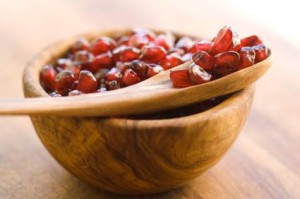Pomegranate is one of the oldest known fruits, originally native to Persia but found in the writings and artifacts of many ancient cultures. Today, pomegranate is widely cultivated in the tropics, subtropics, the Mediterranean region, and Southern California.
If you are unfamiliar with pomegranate, it is a large red fruit with a tough outer skin.
Primarily eaten raw, only the juice and the seeds are edible. Every year in late Fall, you can find me in the evening with a small bowl of fresh pomegranate seeds.
I love the sweet and tangy taste of the seeds. I also love that pomegranate seeds are a nutritional powerhouse, so high in antioxidants that Russian physicians once used them to reduce the effects of radiation exposure after the nuclear disaster at Chernobyl.
Pomegranate seeds are protective against radiation and much more. They are a natural remedy for bladder issues, strengthen the gums, destroy worms in the intestinal tract, and soothe ulcers of the mouth and throat.
They are great for digestion, aiding in the assimilation of protein, fats and carbohydrates.
They contain nitric oxide and tannins called punicalagins that are highly protective against cancer and heart disease.
The fruit also contain potent anti-oxidants and minerals including calcium, magnesium, and potassium.
They are blood sugar supportive, helping to slow the absorption of sugar into the bloodstream. This is beneficial for pre-diabetics, diabetics, and anyone experiencing the highs and lows of a high sugar diet.
Finally, the sweet tangy taste of Pomegranate is helpful for curbing sugar cravings.
Buying and Storing Pomegranates
Look for fresh looking pomegranate during peak season in the fall, late September through December. Pomegranates can be stored in a cool dark place for up to one week, or in the fridge for up to two weeks.
Seeding Pomegranates
Seeding a pomegranate is not nearly as difficult as it sounds. Simply cut open the pomegranate, immerse it in a bowl of cool water for 5 minutes, and then break apart seeds from pulp. By holding the pomegranate submersed in the water, the seeds will sink, while the pulp will float to the top of the bowl. Discard skin and membranes. Dry the seeds on a paper towel.
Preparing Pomegranates
Use pomegranate seeds to add crunch to salads, desserts, appetizers, sauces, and relishes. Or, a fresh pomegranate juice is great for the holidays. Personally, I eat them plain and chilled, right out of the bowl. And, my daughters love them sprinkled over ice cream or sorbet.
You can find my favorite pomegranate salad, Simple Superfood Salad With Pomegranate, here.




